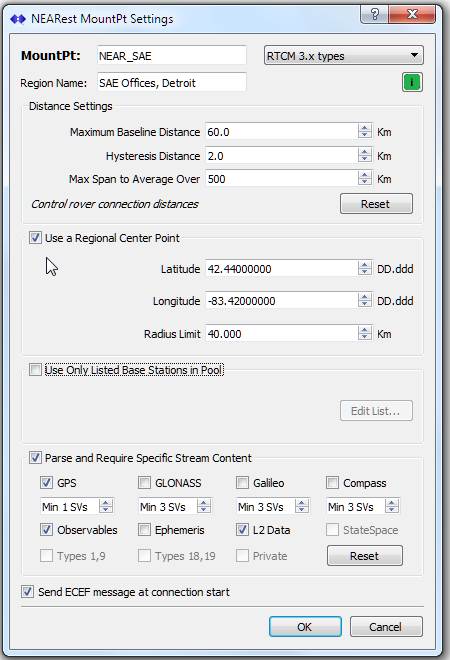In this article the various settings found in the Nearest MountPt Dialog are discussed.
This dialog controls how a NEARest data stream is configured on a SNIP node and therefore which of the other Base Stations will make up the pool to which an NTRIP Client may be connected. A NEAR pool is a set of Base Stations from which an NTRIP Client may choose the closest connection to their reported NMEA-183 location. The NEAR pool is typically made up of Base Stations with common data features, for example; that they all track GLONASS and are located near each other.
The dialog is reached by right-clicking the Edit button on a slot in the the Nearest tab. The settings which are entered here will persist from one run of SNIP to another so that each NEAR stream will restart without further user intervention once it is setup.

The dialog consists of four main areas. The last three are topics discussed in further detail in other articles.
Hint: This Nearest MountPt Dialog makes extensive use of tool tips. If you hover the mouse over any of the controls, much of the usage information presented in the below articles is quickly shown.
The NEAR MountPt Name (and region name)
The MountPt
The MountPt allow naming the NEAR stream in a fashion similar to any other stream. (SNIP will prevent illegal characters from being entered).
It is also common to append some terse regional text to the mountPt such as “RTCM3-SanG” which we use to indicate a NEAR stream operating in the San Gabriel Valley near our offices. Some vendors with VRS solutions often use other terms. As long as your users know what you have decided to call it, little else matters.
The NTRIP format type
The most common use of the NEAR function is to create pools of RTCM 3.x base stations streams. All stream are associated with a format type (including ‘unknown’ when none is provided). The default value for any NEAR pool used with a Basic license is:
- NEAR3 – Used for all type of for RTCM 3.x data streams
Other common format type are supported by the Pro license level and above. These are selected with the combo box at the upper right corner of the dialog. The NTRIP format type supported at this time include: RTCM 3.x, RTCM 2.x, CMR, CMR+, MBEN, JPS, HEMI, LB2, Leica4G, NVS, SBF, R17, R27, uBlox, UBX, BINEX, and ‘unknown’ (indicating any type is to be allowed).
The City-State String
Below the mountPt is a place to enter a human readable string for the mountPt. It’s use is optional. It is common to use the City and State where the mountPt is located, but any string you find useful is valid (SNIP will prevent illegal characters from being entered). In the above example “_SAE” was added to the mountPt and then further text was added here indicating that this NEAR region services needs of a client in greater Detroit, Southeast Michigan, USA area.
The Distance Settings
The distance settings are used to control how far away a given rover can be (the resulting single baseline between it and the base station) and also how sensitive the process of changing to another data stream should be. Here is an article with further technical details.
Use of a Regional Center Point
The regional center point is used to constrain the location of the Base Stations which will form the NEAR pool within a defined region. This allows operating a SNIP node where only a subset of the Base Stations near the defined location should be considered part of a given NEAR pool. Here is an article with further technical details.
Lists of Base Stations
The Base stations considered for any NEAR pool can also be controlled by a user provided list. When this feature is used, only the listed Base Stations are considered, and these station must also meet any of the other parameters as well. This feature is most often used when there is a need to setup two similar NEAR streams with overlapping coverage areas. For example; when running one RTCM 3.x NEAR pool with only Legacy messages (no MSM types) for use by older Rover devices, alongside another RTCM 3.x NEAR pool with both Legacy and MSM message content. Here is an article with further technical details.
Required Stream Contents
The required stream content section provides a means to select only those Base Stations that provide certain data types to be considered for a given NEAR pool. Here is an article with further technical details.
Sending ECEF messages
A final check box marked “Send ECEF messages at connection start” is used to enable a rapid resending of the key location data to any NTRIP Client device when the stream it is connected to changes. This allow an uninterrupted use of the new data observation when they arrive. This supports various automotive safety needs for rapid switching where the normal ~10 second rotation when sending such data would be a delay. It is advised to leave this checked.
The NEARest data stream provides a means for SNIP operators to federate multiple data types into one stream for end user (NTRIP Client) convenience.
